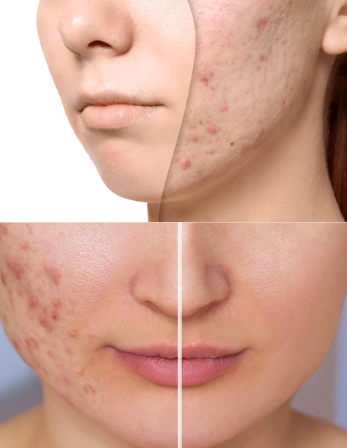
The Battle With Acne Scars
You finally got rid of breakouts, but the scars are still there—textured, pigmented, and stubborn. If you’ve ever touched the spot where a pimple used to be, you know how persistent acne scars can be. They linger long after the blemish is gone, serving as little reminders of what your skin has been through. With so many products claiming to erase scars, it’s easy to feel overwhelmed. The truth is, not every ingredient works. But science does point to a handful of powerful ingredients that actually help fade scars and improve skin texture.
Let’s explore the five best skincare ingredients proven to support skin repair and bring back clarity.
Retinol: Speeds Up Cell Turnover
Retinol, a vitamin A derivative, is one of the most powerful weapons against acne scars. It accelerates cell turnover, helping your skin shed damaged layers while encouraging fresh, smoother skin to emerge. Unlike simple exfoliators, retinol also stimulates collagen production, making it particularly effective for atrophic scars—the sunken, pitted marks that acne often leaves behind.
Clinical studies show that consistent use of retinol over 12 weeks leads to significant improvements in texture, pigmentation, and skin tone. The catch? Retinol can irritate if you overdo it. Start with a low concentration, apply it only at night, and always wear sunscreen in the morning to protect your healing skin. Think of retinol as a slow but steady investment in long-term skin renewal.
Vitamin C: Brightens and Protects Against Pigmentation
Vitamin C is often marketed as a glow-booster, but when it comes to acne scars, its role is much more vital. This powerhouse antioxidant brightens dark spots by blocking excess melanin production and helps prevent scars from looking darker with sun exposure.
Even more impressive, vitamin C is a key player in collagen synthesis, meaning your skin can’t effectively rebuild scarred tissue without it. Studies have found that using a 20% vitamin C serum consistently can noticeably fade hyperpigmentation while improving firmness and elasticity.
The bonus? It shields healing skin from oxidative stress caused by environmental damage. In other words, it not only repairs but also protects your progress.
Video : My $0 ACNE TIPS! It really works 🙌
Niacinamide: Strengthens the Barrier for Even-Toned Skin
Niacinamide, a form of vitamin B3, works quietly but delivers big results. It strengthens the skin barrier, reduces redness, and evens out tone by limiting melanin transfer—the process that causes dark spots to deepen.
It’s especially effective for post-inflammatory hyperpigmentation, the red or brown marks left after acne clears. Beyond fading scars, niacinamide’s calming and anti-inflammatory properties help prevent new breakouts from leaving behind additional scars.
What makes it even better is its versatility. Niacinamide plays well with almost every other ingredient, from retinol to vitamin C, and is suitable for all skin types, even sensitive ones.
Salicylic Acid: Smooths Texture and Fades Dark Spots
Salicylic acid is more than just an acne-fighter. As a beta hydroxy acid (BHA), it penetrates deep into pores, clears out debris, and prevents future breakouts. But it also exfoliates the skin’s surface, helping fade dark marks and improve uneven texture.
Its keratolytic properties—breaking down rough, hardened skin—make it excellent for addressing textural scars. Research shows that salicylic acid peels used over 12 weeks significantly improve both pigmentation and scar depth, particularly in oily and acne-prone skin.
The key is moderation. Using salicylic acid two to three times a week is enough to see benefits without over-drying or irritating the skin. Pair it with a hydrating moisturizer to keep your skin balanced.
Glycolic Acid: Gently Resurfaces Scarred Skin
As the smallest alpha hydroxy acid (AHA), glycolic acid penetrates deeply, speeding up skin cell renewal and fading pigmented areas. It doesn’t just exfoliate—it also stimulates fibroblasts, the cells responsible for collagen production. This makes it particularly helpful in reducing scar depth and roughness.
Clinical studies have shown that glycolic acid peels can significantly smooth acne scars in as little as six sessions. When paired with other actives like retinol or vitamin C, the results become even more dramatic.
But glycolic acid is strong, so beginners should start with lower concentrations and build tolerance. Since it increases photosensitivity, daily sunscreen is a must when using glycolic acid.
Which Ingredient Should You Choose?
Here’s the truth: there isn’t a one-size-fits-all solution for acne scars. The right ingredient depends on the type of scar and your skin’s sensitivity.
- For red or brown marks: Start with niacinamide or vitamin C. They’re gentle yet effective.
- For texture and pits: Retinol, glycolic acid, and salicylic acid each target deeper layers to resurface the skin.
- For sensitive skin or beginners: Niacinamide is the safest entry point before introducing stronger actives.
Consistency is key. None of these ingredients erase scars overnight. But with regular use, they work together to repair, brighten, and smooth your skin over time.
Video : Remove Acne Scars Naturally | 3 Remedies (100% Works) With Results
Conclusion: Building a Scar-Fading Routine That Works
Acne scars may be stubborn, but they’re not invincible. With the right ingredients—retinol, vitamin C, niacinamide, salicylic acid, and glycolic acid—you can gradually fade discoloration, smooth texture, and rebuild healthier skin. Think of these actives as teammates, each tackling a different part of the problem.
Start slow, stay consistent, and always protect your progress with sunscreen. Healing scars is a journey, but with science-backed ingredients on your side, clear and radiant skin is absolutely within reach.


